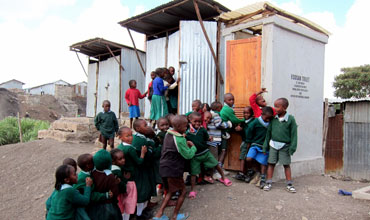Impact of Safe Water and Improved Sanitation on Incidence/Prevalence of Typhoid Fever Globally

Abstract:
Typhoid fever is a systemic infection caused
by the bacterium salmonella typhi. It occurs worldwide and more in developing
countries. This study is a review of existing journals on typhoid fever is
aimed to determine whether safe water usage or consumption and improved
sanitation had an impact on the incidence/prevalence of typhoid fever globally.
A literature search is carried out reviewing
current and existing journals on typhoid fever.
From the view, it was noted in most of the
articles by various authors that safe water usage and improved sanitation
impacted on incidence and prevalence of typhoid fever.
It is however recommended that with
implementation of various public health strategies on safe water, improved
sanitation and personal hygiene there will be a reduction in the incidence of
typhoid fever in our environment.
Vacuration program on Typhoid should be
stepped to further curb the high mortality rate from this water borne disease.
References:
[1.] Condran G.A, Crimmins – Gardner E. (1978) Public Health measures and mortality in US Cities in the late
nineteenth century. Human Ecology 6: 27- 54.
[2.] Crump J.A, Luby S.P et
al (2004). The global burden of
typhoid fever. Bull WHO82:346 – 353.
[3.] Cutter D, Milter G. (2005).
The Role of Public Health improvement in health advances: the twentieth century
United State Demographics 42: 1 – 22.
[4.] Edelman, R and Lerine, M.M (1986) Summary of an International Workshop on typhoid fever. Rev
infect Dis. 8:329.
[5.] Esrey S.A, Feachem R.G, et al (1985).
Intervention for the control of diarrheal diseases among young children;
improving water supplies and excreta disposal facilities. Bull WHO 63, 757 –
772.
[6.] Ipere Polu O.H Gntonu P.E et al (2008), A review
of the disease burden, impact and prevention of typhoid fever in Nigeria West
African J. Med. Jul; 27 (3); 127 – 33.
[7.] Joe Brown, Sandy C., et
al (2011). Sanitation Hygiene
and Enteric Infection in children Arch Dis child 1136 - 30528
[8.] John A Crump, Eric D Muitz, (2010), Global trends in typhoid and paratyphoid fever. Clinical
infect Dis, 50 (2): 241 – 243.
[9.] Microbewiki, (2014).
Typhoid fever in China. Accessed on 28th July, 2014.
[10.] Mohammed H, Mirjam B. (2001). Risk factors for Clinical typhoid fever in villages, South –
Sulanesi, Indonesia. Int. J. of trop Med. Vol. 4 Pg. 91–99.
[11.] Sameen Siddiqiu (1991),
Epidemiologic Patterns and Control Strategic in Typhoid Fever. JPMA pg. (143 to
146).
[12.] Samuel Kariu K, (2008),
Typhoid fever in sub-Saharan Africa: Challenge of diagnosis and management of
infection J Infect Developing Countries 2 (6) 443 – 447.
[13.] Typhoid Vaccine: Who position paper No. 6 (2008) Weekly Epidemiological Report 83:
49 – 60.
[14.] Wikipedia, (2014).
Typhoid Fever. Retrieved 30th July, 2014.

